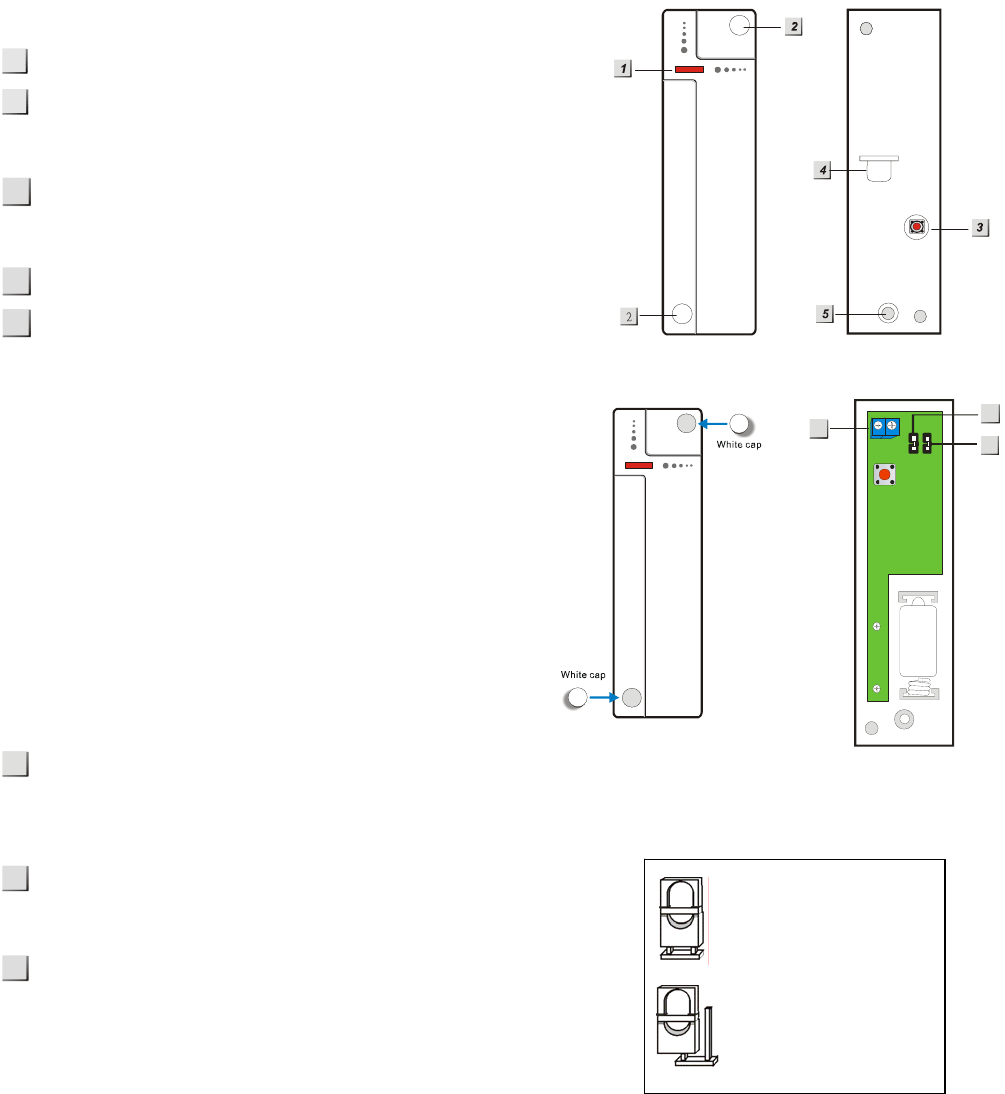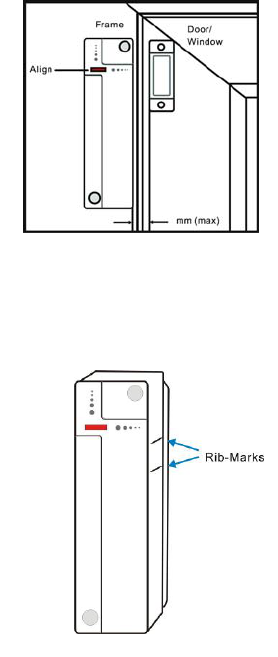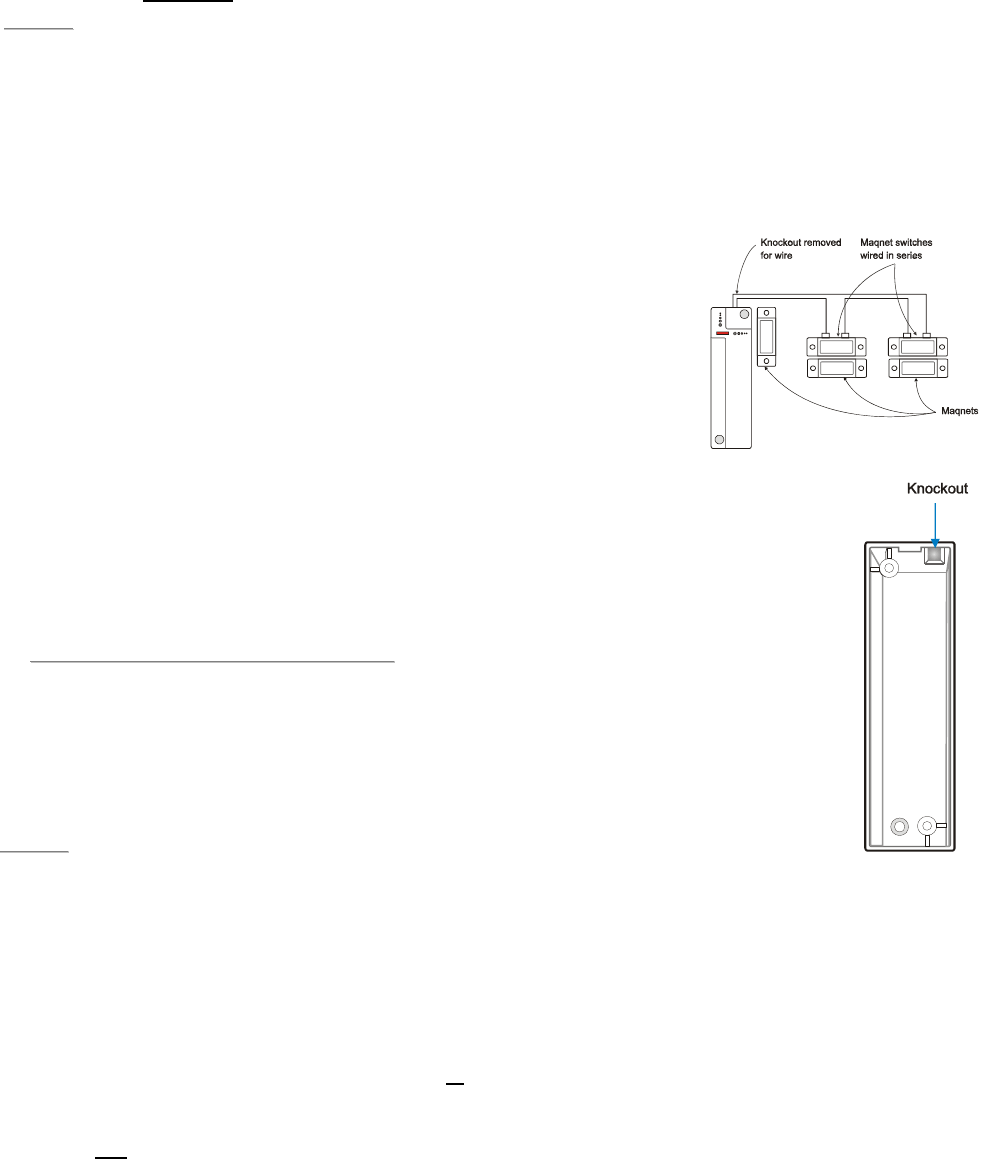Climax Technology Co DCS Door Contact User Manual DC Series
Climax Technology Co Ltd Door Contact DC Series
Users Manual

1
3
Door Contact (DC-15) 433M
The Door Contact monitors the opening/closing of specified devices (e.g. door or window). The Door Contact is fixed to the
monitored device frame with an actuating magnet fixed to the device. An internal magnetic switch activates when the
corresponding device magnet is present or not transmitting device status to the Central Panel. The device also has the
capabilities of communicating signal problems along with low battery situations.
The Door Contact design consists of a cover and base. The cover contains all electronics and the base provides a means for
fixing the device. An enclosed PCB tamper switch provides tamper protection against unauthorized device opening and/or
removal.
z
z
P
Pa
ar
rt
ts
s
I
Id
de
en
nt
ti
if
fi
ic
ca
at
ti
io
on
n
LED indicator a.k.a. Learn / Test button
Mounting Holes
Used to fixed and screw the Door Contact directly onto the Door
Frame or Wall.
Tamper Switch
Provides tamper protection against unauthorized device opening
and/or removal from mounting surface.
Battery Insulator
Fixing Screw
Screw used to secure the top and bottom case of the Door
Contact.
z
z
A
Ac
cc
ce
es
ss
so
or
ri
ie
es
s
I
In
nc
cl
lu
ud
de
ed
d
a) 1 Magnet
b) 2 White Caps
c) 2 Screws
d) 2 Wall Plugs
e) 1 Magnet double-sided adhesive tape pad
f) 2 Magnet mounting screws
z
z
I
In
nt
te
er
rn
na
al
l
S
Sw
wi
it
tc
ch
h
a
an
nd
d
T
Te
er
rm
mi
in
na
al
l
Loosen the bottom fixing screw and remove the cover to reveal
terminal as shown.
Extension Terminal
In addition to the built-in magnet switch, an additional 2-pin dry contact terminal is
provided for an extension magnet switch or any device with N.C. (Normally Closed)
functionality.
JP 2 = Supervision Enable/Disable Jumper Switch
Jumper ON: the Supervision is disabled. (Factory default)
Jumper OFF: the supervision is enabled.
JP 3 = Internal Magnet Switch Bypass Jumper Switch
Jumper ON: the internal magnet switch will be bypassed. Only the
device connected to the Extension Terminal will activate the Door
Contact.
Jumper OFF: the internal magnet switch is in use. (Factory Default)
2
1
4
5
7
6
8
+
7
8
6
Jumper On
The jumper link is inserted
Jumper Off
if the jumper link is removed
or “parked” on one pin.

2
z
z
L
LE
ED
D
I
In
nd
di
ic
ca
at
to
or
r
In Normal Operation Mode, the LED will not light except in the following situations:
z When the Door Contact is in Low battery condition, every time the Door Contact is activated (device opened/
closed), the LED will light.
z When the cover is opened and the tamper switch is violated, the LED will light.
z When a tamper condition persists, every time the Door Contact is activated, the LED will light.
However, if the Device Contact is in Test mode, the LED will flash every time it is activated.
z
z
B
Ba
at
tt
te
er
ry
y
z The Door Contact uses one 1/2 AA, 3.6V Lithium battery as its power source. The Door Contact has a typical
battery life of over 3 years at 50 activations a day on average. Please note: ALWAYS replace battery with the correct
size and voltage.
z Low battery detection operates where the Door Contact has enough reserve power to typically operate for 1 month
before complete exhaustion. When Door Contact is in low battery, the LED will flash and a low battery signal will be
sent to the Control Panel along with regular signal transmissions for the Control Panel to display the status
accordingly.
z When changing batteries, after removing the old batteries, press the Tamper Switch twice to fully discharge before
inserting new batteries.
z
z
S
Su
up
pe
er
rv
vi
is
so
or
ry
y
S
Si
ig
gn
na
al
l
(
(w
wh
he
en
n
t
th
he
e
J
J3
3
i
is
s
O
OF
FF
F)
)
z After installation, the Door Contact will automatically transmit Supervisory Signals periodically to the Control Panel at
random intervals of 30 ~ 50 minutes.
z Failure of the Control Panel to receive a preset Device Contact signal, the Control Panel will display the particular
Device Contact is experiencing an out-of-signal problem.
z
z
T
Te
es
st
t
M
Mo
od
de
e
z Each press of the Test Button causes the Door Contact to transmit a radio range test signal to the Control Panel and
will enter the test mode for 3 mins. When the test signal is transmitted, the LED will flash to confirm signal receipt by
the Control Panel.
z Each additional Test Button press will extend Test Mode another 3 mins.
z
z
G
Ge
et
tt
ti
in
ng
g
S
St
ta
ar
rt
te
ed
d
z Remove the fixing screw and cover assembly.
z Insert the “1/2 AA” battery into the battery holder connecting the polarity correctly.
z The LED indicator will flash briefly, please wait for 10 seconds.
z Put the Control Panel into (Device +/-) menu and then select (Add Device) menu.
z Press the Door Contact test button.
z Refer to your Control Panel operation manual’s section of (Device +/-) to
complete the learn-in process.
z After the Door Contact is learned-in, place the Control Panel into (Walk Test)
mode, hold the Door Contact in the desired location, and press the Test button,
the LED will flash to confirm that this location is within signal range of the Control
Panel.
z Proceed with mounting and installation once you are satisfied that the Door
Contact location functions properly.
z
z
M
Mo
ou
un
nt
ti
in
ng
g
M
Me
et
th
ho
od
ds
s
a
an
nd
d
I
In
ns
st
ta
al
ll
la
at
ti
io
on
n
It is recommended that the Door Contact should be placed on the door frame and the
magnet on the door. If the door contact is placed on the door.
Step 1: Find a suitable location close to your door/window to install the Door Contact.
Step 2: The Door Contact has 2 rib-marks on one side (refer to figure), marking the
internal magnet switch location. The door contact should be installed either
upright or inverted, to ensure that the rib-marked side face the magnet.
Step 3: To mount the Door Contact:
(i) Using the 2 Door Contact mounting holes as a template for appropriate
hole positioning.
(ii) Use the provided wall plugs for plaster/brick installation.

3
(iii) Screw the Door Contact into the provided wall plugs.
Step 4: Fit the magnet on the door using the small piece of double sided adhesive tape or with provided screws. The
magnet must align with the marked side of the door contact as shown in figure.
<
<
N
NO
OT
TE
E
>
>
) The magnet should not be more than 15 mm from the detector when the door is closed.
) Ensure the tamper switch spring is positioned so that it makes contact with the mounting surface through the
tamper switch aperture.
) Windows can be protected similar to door installations. When fitting to a window fix the magnet to the moving
window part and the door switch to the stationary frame.
Step 5: Put the Control Panel into (Walk Test) Mode, and press the Test Button on the Door contact. This enables the
LED indicator to flash every time the Door Contact is operated.
Step 6: Fit the white caps to the two mounting holes of the Door Contact.
Step 7: Installation is now complete.
z
z
U
Us
si
in
ng
g
t
th
he
e
E
Ex
xt
te
en
ns
si
io
on
n
T
Te
er
rm
mi
in
na
al
l.
.
The Door Contact has an Extension Terminal providing enhanced installation flexibility.
The Extension terminal may be useful for the following:
z If the Door Contact cannot be mounted on the door frame, you can connect an
additional (extension magnet switch) to the (Extension Terminal) mounting
the Door Contact remotely.
z More than one window and door can be protected by a Door Contact using the
additional magnet and extension magnet switch. The switches must be wired to
the (Extension Terminal) as shown:
z Any dry contact device with N.C. (Normally Closed), such as a Broken Glass
detector, Smoke Sensor, Gas detector, Water Sensor etc, can be connected to
the (Extension Terminal) making the Door Contact serve as an (Universal
Transmitter).
C
CO
ON
NN
NE
EC
CT
TI
IO
ON
N
T
TO
O
E
EX
XT
TE
EN
NS
SI
IO
ON
N
T
TE
ER
RM
MI
IN
NA
AL
L:
:
Step 1: Open the Door Contact by loosening the fixing screw.
Step 2: The upper end of the front case has a thinner plastic knockout. Break through
the knockout creating a hole for the wiring connection to the Extension
Terminal.
Step 3: Connect the external device(s) to the Extension Terminal as shown in the
diagram.
<
<N
NO
OT
TE
E>
>
) The Extension Terminal forms a closed loop with the device connected to it. When the
Loop is opened (the device is triggered), the Door Contact is activated.
) The device connected to the Extension Terminal is in series with the internal magnet Switch. Meaning both
can work together simultaneously.
) You can choose to use the Extension Terminal alone with the internal magnet switch bypassed or to use both
together.
) If both the Internal Magnet Switch and Extension Terminal operate together, then:
When the protected door is opened/closed or the external device is triggered, the Door Contact activates and
transmits a signal.
However, the Door contact will only transmit a (Door Closed) or (Restored Signal) after the protected door
and the external device are restored.
FCC Statement
This device complies with Part 15 of the FCC Rules. Operation is subject to the following two conditions:
(1) This device may not cause harmful interference, and
(2) This device must accept any interference received, including interference that may cause undesired operation.
FCC Caution:
To assure continued compliance, any changes or modifications not expressly approved by the party responsible for compliance may
void the user's authority to operate this equipment. (Example - use only shielded interface cables when connecting to computer or
peripheral devices).